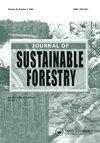野生食用果树的可持续利用和管理——以印度尼西亚西亚齐乌鲁马森保护林为例
IF 1.8
4区 农林科学
Q3 FORESTRY
引用次数: 4
摘要
摘要:野生食用果树(WEF)是指未经栽培或驯化,但在其自然栖息地可以获得的物种,为当地人民提供了现成的食物、药品和经济价值来源。近年来,世界经济论坛受到过度开发、土地利用变化和生物多样性丧失的威胁。本研究旨在(1)识别和记录野生食用果树物种,(2)调查乌鲁马森保护区WEF的知识、使用和管理模式;以及(3)评估对野生可食用果树物种的威胁,并为其保护提出可能的管理方案。该研究在印度尼西亚亚齐东南部Pantai Ceuremen街道的六个村庄进行,即Sikundo、Jambak、Cangai、Lawet、Pulo Tungoh和Keutambang。植物材料是从研究区域随机收集的,而当地知识是通过半结构化调查和深入访谈收集的,涉及209名受访者,他们是通过随机抽样选出的。共发现21科30属53种野生食用果树为常用果树。pycnanthum、Syzygium littoralle、Syzygium polyanthum,黄壶藤、多菌Baccaurea polyneura、黄曲霉Flacoutina rukam、Sandoricum koetjape和总状杆菌是研究区当地群落最重要的物种。研究区域的WEF受到多种因素的影响,主要是农业扩张,这意味着需要通过实施管理战略来改善保护做法,优先考虑当地社区目前使用的物种。基于传统知识的管理战略,如基于社区的森林管理系统,正在考虑用于未来的养护,其他情况类似的发展中国家也在实施这些战略。本文章由计算机程序翻译,如有差异,请以英文原文为准。
Sustainable Use and Management of Wild Edible Fruit Plants: A Case Study in the Ulu Masen Protected Forest, West Aceh, Indonesia
ABSTRACT Wild edible fruit plant species (WEFs) are species that are not cultivated or domesticated but are available in their natural habitat, providing a readily available source of food, medicine, and economic value to the local people. In recent times, WEFs have been threatened by over-exploitation, land-use changes, and biodiversity loss. This study aims to (1) identify and document wild edible fruit plant species, (2) investigate the patterns of knowledge, use, and management of WEFs in the Ulu Masen protected area; and (3) assess threats to wild edible fruit plant species and recommend possible management scenarios for their conservation. The study was conducted in six villages of Pantai Ceuremen subdistrict, Southeast Aceh, Indonesia, namely Sikundo, Jambak, Canggai, Lawet, Pulo Tungoh, and Keutambang. The plant materials were randomly collected from the study area, while local knowledge was gathered through a semi-structured survey and in-depth interviews involving 209 respondents that were selected using random sampling. A total of 53 wild edible fruit plants from 30 genera and 21 families were found to be commonly used. Syzygium pycnanthum, Syzygium littorale, Syzygium polyanthum, Garcinia xanthochymus, Baccaurea polyneura, Flacourtia rukam, Sandoricum koetjape, and Baccaurea racemosa were the most important species for local communities in the study area. The WEFs in the study area is influenced by a variety of factors, primarily agricultural expansion, which means that conservation practices need to be improved through the implementation of management strategies, prioritizing species currently used by local communities. Management strategies based on traditional knowledge, such as community-based forest management systems (CBFMS) are being considered for future conservation, and they are also being implemented in other developing countries with similar circumstances.
求助全文
通过发布文献求助,成功后即可免费获取论文全文。
去求助
来源期刊

Journal of Sustainable Forestry
Social Sciences-Geography, Planning and Development
CiteScore
3.90
自引率
12.50%
发文量
42
期刊介绍:
Journal of Sustainable Forestry publishes peer-reviewed, original research on forest science. While the emphasis is on sustainable use of forest products and services, the journal covers a wide range of topics from the underlying biology and ecology of forests to the social, economic and policy aspects of forestry. Short communications and review papers that provide a clear theoretical, conceptual or methodological contribution to the existing literature are also included in the journal.
Common topics covered in the Journal of Sustainable Forestry include:
• Ecology, management, recreation, restoration and silvicultural systems of all forest types, including urban forests
• All aspects of forest biology, including ecophysiology, entomology, pathology, genetics, tree breeding, and biotechnology
• Wood properties, forest biomass, bioenergy, and carbon sequestration
• Simulation modeling, inventory, quantitative methods, and remote sensing
• Environmental pollution, fire and climate change impacts, and adaptation and mitigation in forests
• Forest engineering, economics, human dimensions, natural resource policy, and planning
Journal of Sustainable Forestry provides an international forum for dialogue between research scientists, forest managers, economists and policy and decision makers who share the common vision of the sustainable use of natural resources.
 求助内容:
求助内容: 应助结果提醒方式:
应助结果提醒方式:


